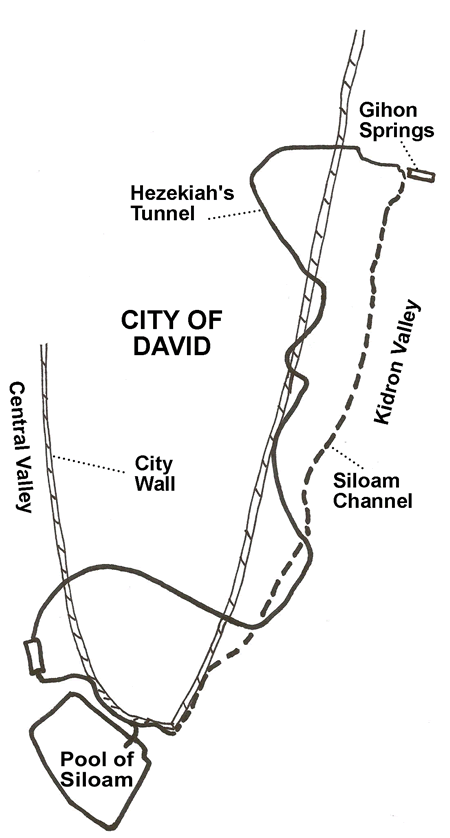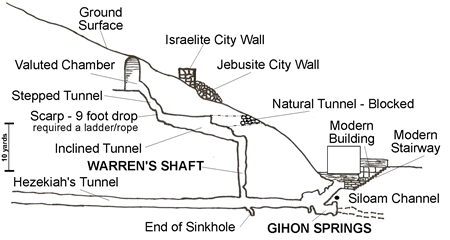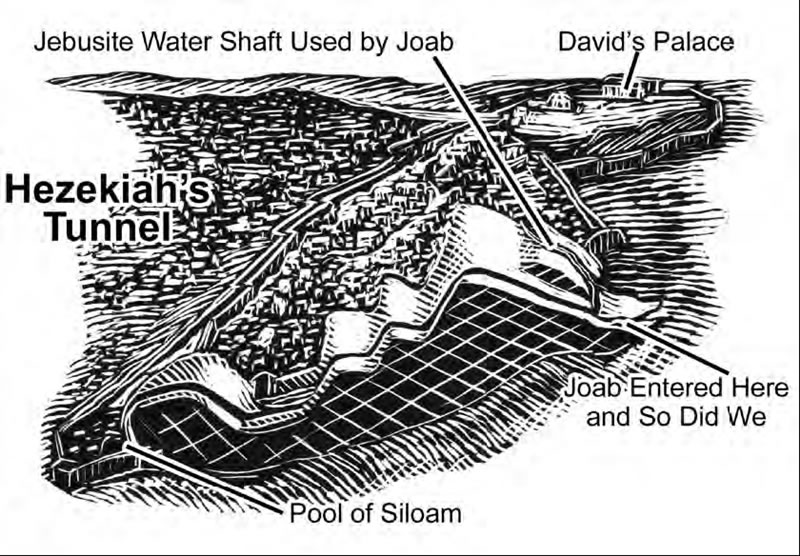| 25- Hezekiah's Tunnel | |||
| Warren's Shaft | Pool of Siloam | Tradional Pool of Siloam | Siloam Channel |
| Hezekiah's Tunnel | Sluice Gate | ||
 |
|||
Hezekiah's Tunnel - back to the top Hezekiah’s Tunnel was cut through bedrock in 701 BC under the City of David, curving and weaving for 1750 feet. If the same tunnel were cut in a straight line, it
|
|||
The pick marks of Hezekiah’s workers are still visible on the rock walls and ceiling of this 1,750 foot tunnel. |
|||
Hezekiah’s Tunnel is about 2 feet wide and 5 feet high at the entrance near the Gihon Springs, as seen in this photo. Notice the fresh water still moving through this tunnel as it has for 2,700 years. |
|||
|
Hezekiah Tunnel from Galyn Wiemers on Vimeo. |
|||
The point where the two crews finally met can be identified by at least three things besides the winding, weaving and false starts that proceeded it.
Sluice Gate The Gihon Springs had abundantly provided water on the east side of the original city of Jerusalem (Salem, Jebus, City of David). But, with the diversion of the water from the Gihon Springs through Hezekiah’s Tunnel to the south into the Pool of Siloam the water supply to the north on the eastern side of the city would be drastically lowered. To control the water level at its source Hezekiah would need a plan to justify and monitor the diverting of the water to the other side of the city. The resolution was the planning, installing and using a sluice gate along the route of Hezekiah’s Tunnel. This sluice gate would not only be politically acceptable to the citizens of the city by doubling available access to the city’s water, but it was also a strategically proactive military maneuver in preparation for the rising threat of an Assyrian siege. This very logic is recorded in a quote by Hezekiah’s team designing this tunnel: “Sennacherib king of Assyria came and invaded Judah and encamped against the fortified cities… And when Hezekiah saw that Sennacherib had come and intended to fight against Jerusalem, he planned with his officers and his mighty men to stop the water of the springs that were outside the city; and they helped him. A great many people were gathered, and they stopped all the springs and the brook that flowed through the land, saying, “Why should the kings of Assyria come and find much water?” He set to work resolutely and built up all the wall that was broken down and raised towers upon it, and outside it he built another wall, and he strengthened the Millo in the city of David. He also made weapons and shields in abundance…Hezekiah closed the upper outlet of the waters of Gihon and directed them down to the west side of the city of David. And Hezekiah prospered in all his works.”
This device, the sluice gate, would control the water level in Hezekiah’s Tunnel while also allowing the pools on the north end of the tunnel to fill when the sluice gate was closed. But, also, when the sluice gate was open it would cut off the supply of water to the pools and channels outside the city walls that would be available to an attacking military. The sluice gate was found to have been constructed 233 feet from the south exit of Hezekiah’s Tunnel. It is at this point evidence of a formerly functioning sluice gate is plentiful. Besides the logic that some form of control of the water supply for both sides of the city was an absolute necessity, there is evidence that this sluice gate did exist. There are signs of where it operated in the tunnel. To make room for this tall, vertically-sliding gate to be raised up above the water level the ceiling would have to be cut higher than the 5-7 foot high ceiling cut south from the Gihon Springs. The point in Hezekiah’s Tunnel were the ceiling height goes from 6 feet to 19 feet is 233 feet from the south exit of the tunnel.
A few feet north of this point is a natural shaft (similar to Warren’s Shaft) that extends from the ceiling of the tunnel through a passage and then up and out to the surface above. There is also an indication of a metal device to guide the rope found in the traces of smelting ore that remain on the ceiling of the tunnel directly above the location of the gate.
The tall, vertical gate would have been made of wood (scientific examination indicates cedar wood) which would slide up and down in two wooden grooves,
|
|||
The water naturally flows from the Gihon Springs to the Pool of Siloam because the tunnel was cut using a 12 inch (0.6‰) gradient altitude difference between each end of the 1,750 foot tunnel. |
|||
The tunnel is 130 feet below the ground surface above on the Ophel. |
|||
|
|||
|
|||
 |
|||
| Toni in 2012 | |||
|
|||
Galyn Wiemers in Hezekiah's Tunnel in 2007. |
|||
|
|||
|
|||
|
|||
|
|||
|
|||
An imitation of the actual stone and the inscription that was removed and taken to a museum in Istanbul, Turkey. |
|||
Stairs leading out of Hezekiah’s Tunnel to an open channel, through which the water flows into the Pool of Siloam. |
|||
Siloam Channel - Traditional Pool of Siloam - back to the top
|
|||
A view of the open channel from the exit of Hezekiah’s Tunnel. The Pool of Siloam is just a few feet on the other side of the gate that is seen at the end of the
|
|||
|
|||
 |
|||
 Warren's Shaft - The water from the Gihon Springs followed a natural tunnel to the base of a shaft discovered by Warren. Joab could have entered through Warren's Shaft, or he may have used the natural tunnel before it was blocked to access the inclined plane and ascend into the city. |
|||
 |
|||
Pool of Siloam - back to the top
|
|||
|
|||
 |
UPDATED! 2022 - Open this link |
JERUSALEM: HISTORY, ARCHAEOLOGY AND Download a FREE online .pdf of "Jerusalem" HERE (click on the book cover to download the book as a .pdf ) |
|
|
|
|
|